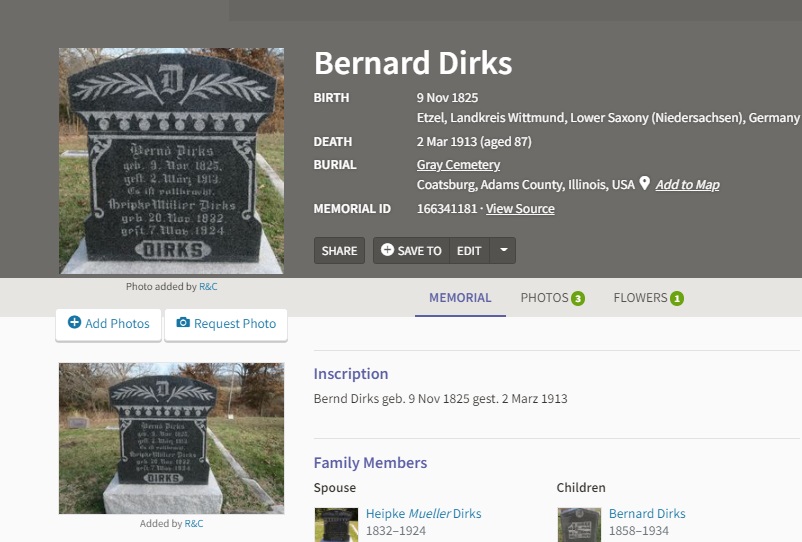FindAGrave memorials are like any compiled source. Many contain a significant amount of material not on the actual stone itself. Verify the information the memorial contains.
Pictures of tombstones are probably reliable images of the original. Some photos make the inscription easier to read and others do not. Some photos are good, high-resolution images where magnification can enhance the readability. Others become pixilated. Transcriptions of what is on the stone can be incorrect–even when the transcription is easy to read. Supplemental information on the individual referenced on the tombstone may be correct–or it may be not. Treat that information as you would any other piece of information: verify.

Some memorials have precise dates of birth and death where the stone only has a year–verify. Some memorials have a place of birth where the stone does not–verify. The same is true for any relationships indicated on the memorial as well.
Information on burials where no stone picture is included and no source for why the memorial compiler indicated the person was buried in the cemetery are always a little suspect. Death certificates, cemetery records, obituaries, earlier cemetery transcriptions, and other sources are places to verify the place of burial when no stone actually exists.
Help support Genealogy Tip of the Day by visiting any of the following sites:
- Try a GenealogyBank Genealogy Search to see what you find.
- AncestryDNA offers
- Books on Michael’s Genealogy Shelf







2 Responses
Also, please know that information on the stone itself may be wrong! Just because it is carved in stone (literally) does not mean it is correct either.
A lot of us used cemetery records to list the burials. Pictures don’t normally come with those. When I saw that the cemetery my dad and many other family members were buried in was not on findagrave (years ago), I used the cemetery association’s records that were posted at the front gate and a book compiled in the 1970s from a walk-through that some of the local historians had made. And I’ve driven to Louisiana many times and gone through taking photos of the gravestones, trying to get all of them online and identified. Even so, there are some duplicates and many that no longer have markers or never did. And some conflicting information, too. Death certificates and obituaries are good sources, but still not foolproof. And findagrave has an automatic acceptance of suggestions made if the person who posted the memorial page does not check in to verify them before that period is up. I’ve had a couple of messes that happened while I was dealing with health issues and someone made bogus suggestions that were auto-accepted like that.
So, yes. always, ALWAYS look for proof. Most of us do our best to double-check and look for proof before we post most memorials. Many of us try to connect to other family members, even if we don’t know the family and have to do a bit of research to identify their kinfolks. It is worth the effort, when we have the time to do it. Some of the contributors live and breathe to get those records online, connected, and correct.
And yes, a lot of gravestones have incorrect information, too. Most are correct, but when one has no gravestone for years, or if one is replaced, dates and names often get changed, although it’s not intended to get it wrong. My ggg-grandfather’s gravestone says he died one year, but his death certificate and obituary say another year. And one of my gg-grandmothers had a gravestone that was damaged. I lucked out and found that some cousins were about to replace it. When I contacted them to donate to the cause, I asked what years they were listing for her. They were about to get it wrong and I had proof of the correct dates. So, at the very last minute, a change happened to get it right. I was thankful to happen along when I did.
This was a good article. I hope some of my added info is helpful.